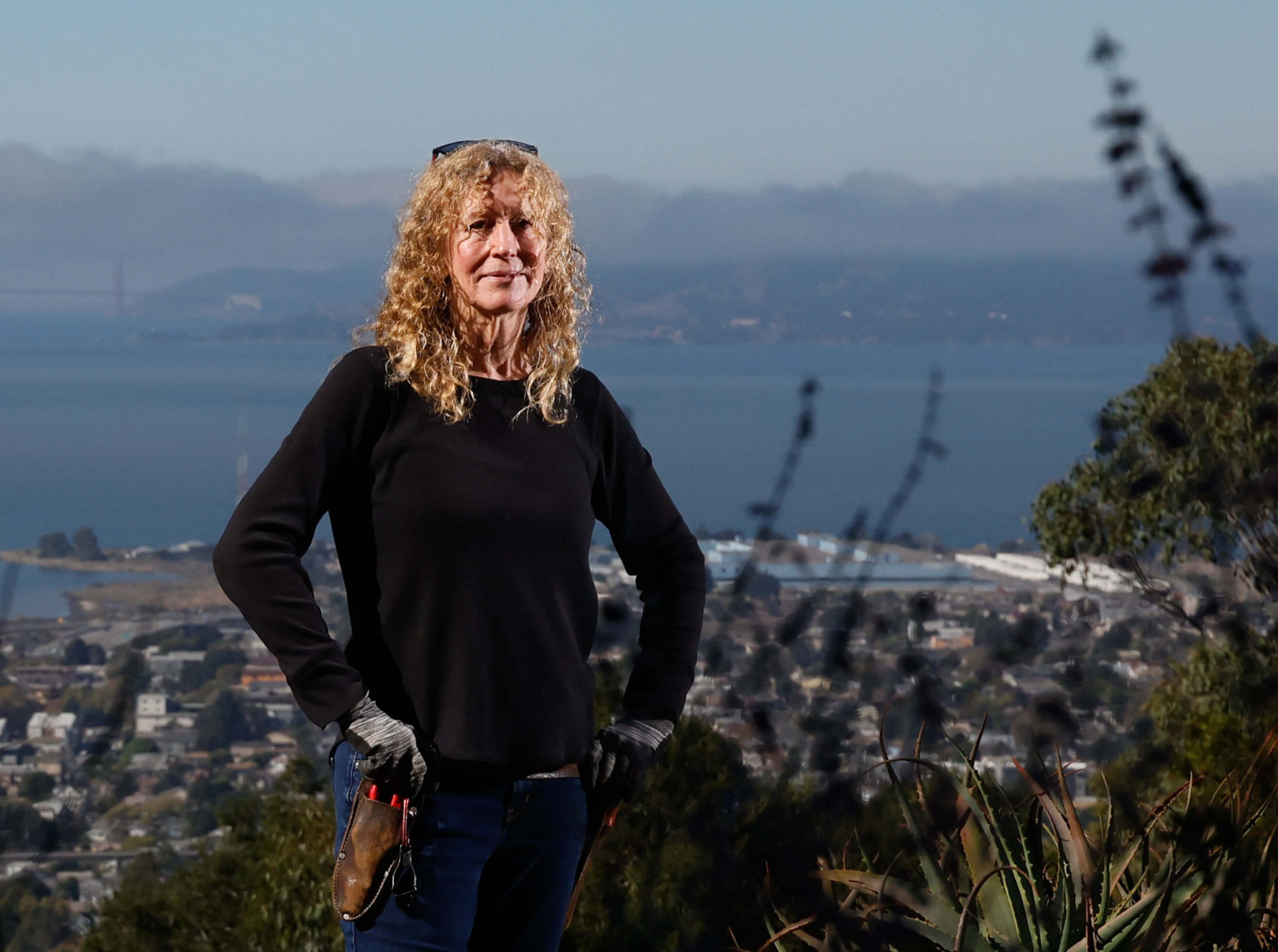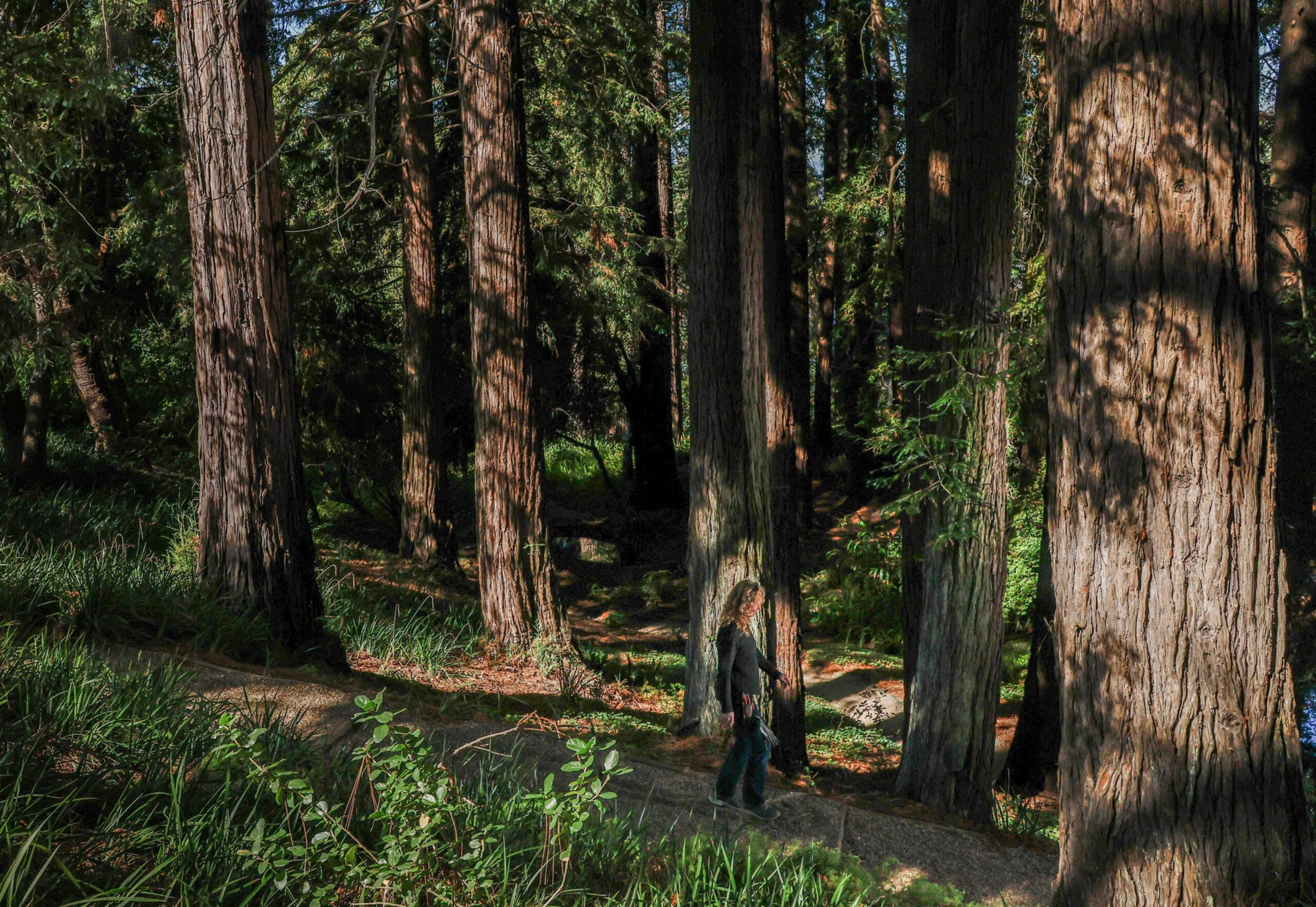There’s something magical about the Blake Garden—beyond the simple fact that it exists at all, hidden in plain sight along a residential suburban street. Maybe it’s that you can get lost in such a small amount of space. The paths and steps lead a visitor mysteriously from one verdant zone to another; before you know it, you’ve turned a corner from flowering succulents into a redwood dell. I know I’m in the East Bay, but I might as well be in Middle Earth.
Never heard of Blake Garden (opens in new tab)? Neither had I until a friend mentioned it a couple of months ago. One reason for its relative anonymity is that, as part of UC Berkeley’s Department of Landscape Architecture, the Kensington garden keeps bakers’ hours: from 8 a.m. until 4:30 p.m., weekdays only, making it a difficult visit for full-time folks.
But it’s worth a sick day.
After finding the office I’m met by Meghan Ray, a tall and engaging horticulturist who worked for the UC Berkeley Botanical Garden for 12 years before transferring to Blake. The garden, she explains, is divided into six main sections (and many smaller ones), connected by a web of trails and punctuated by Andy Goldsworthy (opens in new tab)-like constructions.

Meghan grew up in New York, and her family frequently visited the New York Botanical Garden. “I feel like that probably inspired the idea of gardening— although the things we used to do in that botanical garden, they certainly don’t let you do anymore. We used to go ice skating on the wet meadow, and climb the pine trees.”
Blake Garden is bordered by two creeks, North and South. Both are tributaries of Cerrito Creek and flow into the bay. When it rains in Kensington, it pours in Blake Garden: most of the water enters South Creek from the town’s storm drains. Though it covers only 10.5 acres, the garden hosts more than 1,000 plant species, and over 50 species of birds—as well as butterflies, amphibians, and some mammals (the park is also dog-friendly).

I’m sort of obsessed with flowers. But since it’s summer, on the heels of a heat wave, I don’t expect to see much in bloom. Blake Garden surprises me; there are flowers everywhere, from rock roses and rosemary to asters and Matilija poppies.
Meghan leads me past a square, Moorish-inspired pool to the “Lookout,” a small plaza with a fabulous view. From there we descend into the “Australian Hollow.” The spring-fed depression was originally intended to be a lake, but that plan never materialized. Instead, it was restored as a California native wetland, dominated by tule grass and cattails.

Odd structures pepper the garden. We pass a crude, oversized chess set made of redwood and cedar, and a long cane tunnel snaking off the trail. There’s a huge rocky outcropping, which begs to be climbed (the “No Climbing” sign notwithstanding). As we enter a small clearing, Meghan points out a pipe-organ-like sculpture, built by a student as a breeding place for solitary bees. This amazes me: I never even knew that there were solitary bees. It strikes me as a lonely life, bereft of honey.
Maybe it’s the lack of symmetry in so many parts of the garden that makes the place seem almost feral—while at the same time you know it has been carefully cultivated. But any impression of wildness evaporates at the Blake House itself. Though it’s now abandoned as unsafe (sitting right on an earthquake fault) it still shelters the formal gardens from the Golden Gate winds. On the east side of the house is the grotto, built by Italian stone masons. The small cavern overlooks a reflecting pool stocked with 15 colorful, kinetic koi.
Meghan sighs. “You know, we do a lot of tours with kids, and I think I’m showing them some pretty interesting things. But at the end, when I ask their favorite part, they always say, ‘The fish!’”

What Blooms from a Loan Default
Blake Garden has a fascinating if convoluted, history. Once upon a time, the Blake family lived in three stately mansions on Berkeley’s (not Oakland’s) Piedmont Avenue. When the University of California decided to build Memorial Stadium on that very parcel, they claimed eminent domain—and sent the Blakes packing.
Fortunately, Mrs. Harriet Styles Blake owned 45 acres of property nearby. Originally a tiny part of the 17,000 Rancho San Pablo, the parcel was bought in the early 1900s by a real estate developer who’d borrowed the money from Mrs. Blake. But he defaulted on the loan, and Harriet wound up with 45 very scenic acres—just when the Blake family needed a place to go.
And so she partitioned the land into four parcels, offering one to each of her four children. Only Anson and Edwin Blake took her up on that offer; the others sold their property for residential development.
“If it hadn’t been for that default in the 1920s,” Meghan observes dryly, “this whole garden would be houses—just like everything else around us.”

Okay. So, the Edwin and Anson Blake brothers had 20 acres between them. As it happened, Mabel Symmes—Anson’s sister-in-law—was one of the very first students (in 1913) of Cal’s Landscape Architecture Department. It was decided that Mabel and Anson would collaborate on the garden, while Walter Bliss—a locally known architect—would design their homes. One is now the Blake House; the other, a Carmelite monastery housing sequestered nuns.
“Unlike a lot of houses and gardens,” says Meghan, “this house and garden were designed at the same time. So they’re really part of one artwork.”
It’s approaching 4:30 p.m.—time for Meghan to ferret out stragglers and lock the gates. As she walks me out we detour through the Rose Garden, in late summer bloom.
The spring, I assume, must be the best time to see the garden’s full spectrum of flowers. Meghan nods but adds a caveat.
“People are drawn to flowers. But there are so many other things to appreciate about plants and plant design, all year round. There are the structural things, like leaves, stems, and fruits. And there’s also the roles plants play in drawing pollinators and other wildlife.
“Those things are visible if you take a minute and appreciate the shapes and textures and forms of the plants,” she says, “besides just looking at their flowers.”
Point taken.
_______
Blake Garden is located at 70 Rincon Road in Kensington, a bit northeast of Berkeley. It’s open to the public Monday through Friday, 8 a.m. until 4:30 p.m. The garden is closed on weekends and university holidays. See the website (opens in new tab) to register for the occasional garden tours and bird walks.
Correction: An earlier version of this article misstated Meaghan Ray’s position at the UC Berkeley Botanical Garden. She was a horticulturist there.
